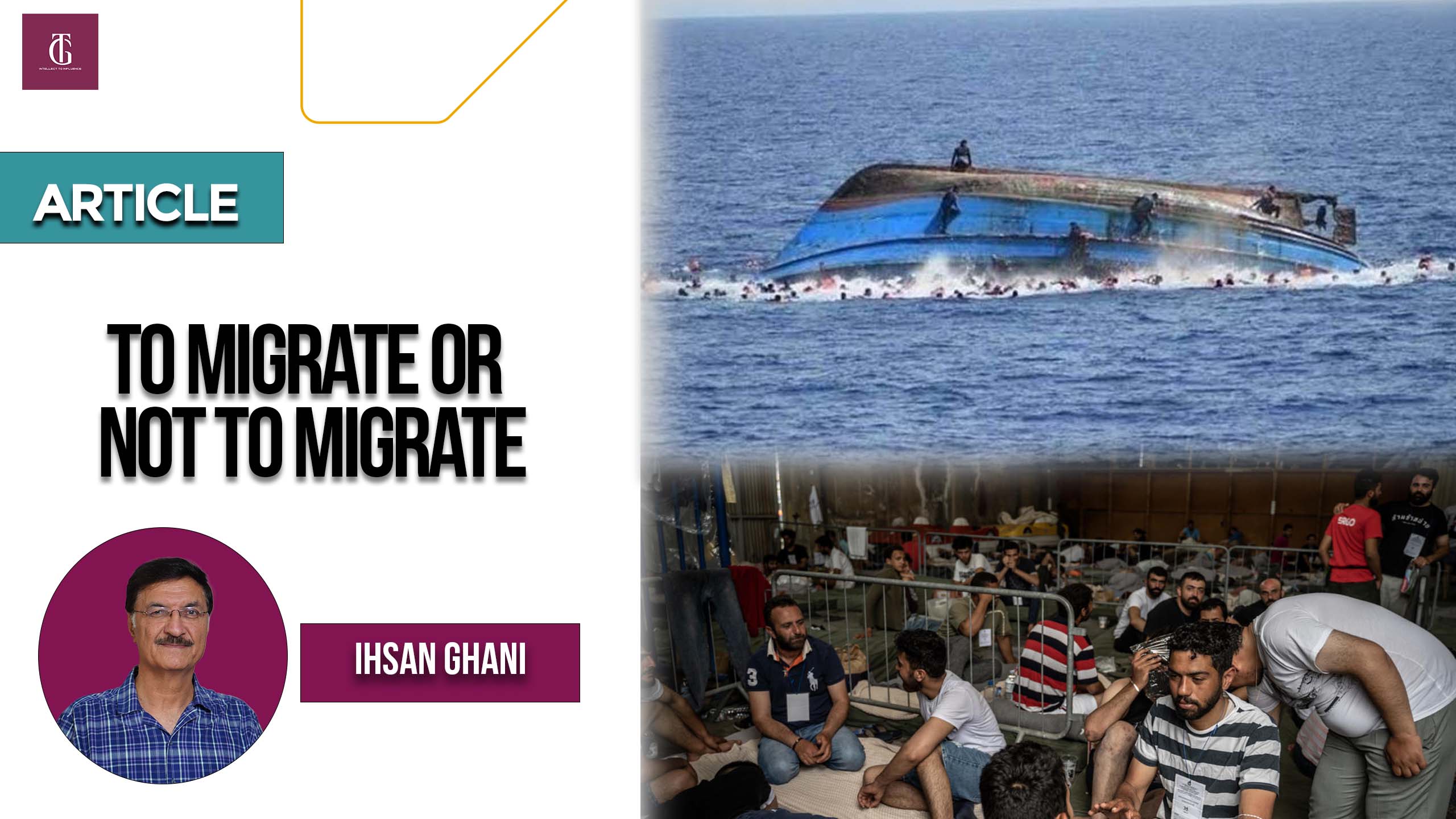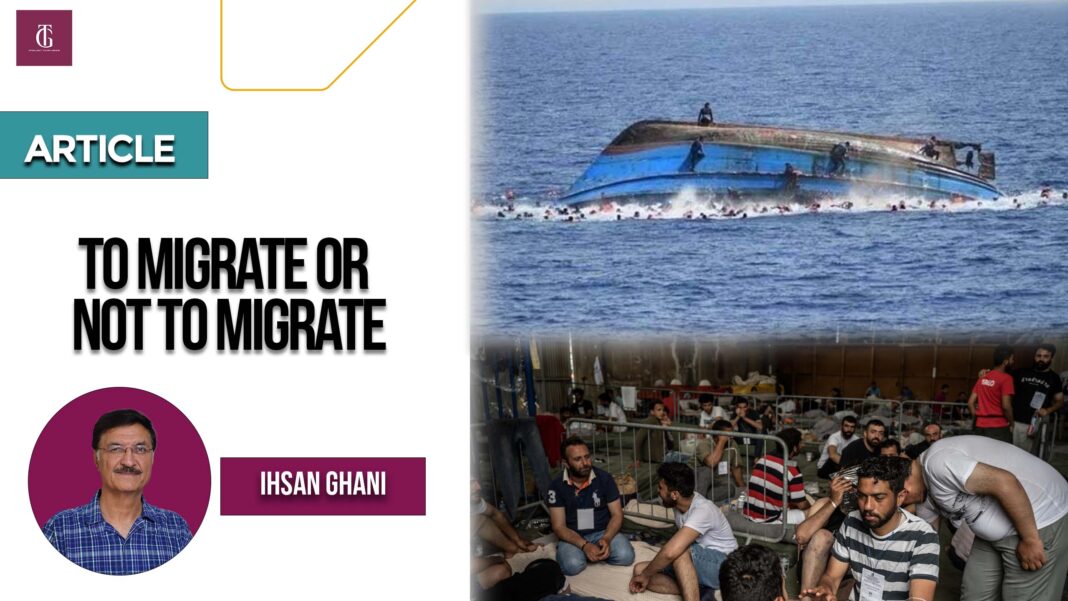
Homo Sapiens migration is almost as old as the Homo Sapiens themselves, around 100,000 years when they left their abode in the African continent and populated parts of Europe and Asia. They reached the Australian continent in canoes sometime between 35,000 and 65,000 years ago. Scientists studying land masses and climate understand that the Pleistocene Ice Age created a land bridge that connected Asia and North America (Alaska) over 13,000 years ago. A widely accepted migration theory is that people crossed this land bridge and eventually migrated into North and South America.
So, why is it a problem now?
Understanding the risks and opportunities of modern-day migration is not an easy phenomenon. It could very well be a source of prosperity and innovation, as it has been throughout the history of Mankind, but it could also usher in untold miseries and countless deaths. During the twentieth century, the Great Depression, the World Wars and decolonization, etc. caused major cross-border displacement.
The world today, according to the UN High Commissioner for Refugees (UNHCR), is currently witnessing some of the largest migrations on record. At the end of 2022, there are 108.4 million displaced people worldwide who have fled their homes due to conflict and persecution, also referred to as ‘involuntary migration’.
Pakistan is a country with one of the world’s highest rates of migration, from where migrants depart for their destination countries by different networks using variant modalities, being a source, transit, and destination country for men, women, and children subjected to trafficking in persons, specifically forced labor and prostitution.
In the provinces of Sindh and Punjab, over a million humans are trafficked, primarily for bonded labor to be used in agriculture, brick making and mining, and carpet making. Human smuggling has become one of the most lucrative and fastest-growing criminal enterprises because of the “low risk- high profits” ratio. Trafficking in person is not confined to underdeveloped or developing countries as this plague is rampant throughout the world, including in Europe and the United States.
The many push-and-pull factors compelling and attracting people to the path of migration could include labor including bonded labor, human rights violations (including issues that arise out of religious, sectarian beliefs / racial or ethnic prejudices, regional or provincial biases), migration for better living standards for freedom of expression, search for better living standards, asylum due to political oppression, Commercial activities, forced prostitution and child trafficking, that has shown significant rise linked to the alarming increase in online child pornography, including live streaming of sexual abuse of children could come to mind. This lucrative business is estimated to generate $3–$20 billion annually in profits.
Some of the issues involved could include:
- As a concept and not a rule, the smuggling process involves the recruitment of migrants and their transportation. In some cases, even their integration into destination countries.
- Over the years each state has, depending on its national interests, priorities, and capacity to absorb migrants, formulated rules for entry, transit, and stay of migrants. These are generally restrictive and at times are defined by the preference of states for certain types of migrants (usually high-skilled migrants). This all sounds very well but many individuals who wish to migrate do not satisfy these legal requirements. When reasons to migrate become compelling, they seek illegal means. That is where the smugglers come in to assist migrants in evading migration controls and enable them to irregularly enter and stay in destination countries. Due to the high profits involved and the porous state borders, especially in cases of sea and land routes, smugglers have become experts and adopted innovative means to defeat state border management apparatus. As such migrant smuggling has evolved into an organised crime.
- Generally, a complex network of individuals and resources is established that relies on national, regional, and global actors. These operate through family, friends, or membership of the same ethnic group or community. There is a relationship at work between smugglers and smuggled migrants, family and friends who generally invest and sponsor the venture, and even individuals along the smuggling routes who are paid for services.
- Racial, ethnic, social, gender, age group, tribal affiliations, and financial status of the migrants also determine the costs and treatment extended to them. There are vulnerable groups who suffer from multiple disadvantages, including but not limited to the fact of being far from home, mostly in alien regions with no friends or relations. Many will not know the language, cultural habits, and logistics in transit and destination countries. Women, unaccompanied minors, and people with disabilities are particularly handicapped.
- The mechanics involved often are dangerous coupled with great personal risks. These risks increase depending on the vulnerability of the migrants. As in every illegal, risky, profitable venture, here also there is a nexus between these smugglers and, depending on the situation, national, regional and international organized criminal gangs. They are often involved in most phases of the smuggling process. They may provide fraudulent documents, arrange transportation, and even en-route protection. As they have acquired capacity and connections with border officials, they can extend the same facilities to the smugglers as well for a hefty fee.
Figure 1: Migration Routes around the World (: UNODC, Global Study on Smuggling of Migrants, 2018, p. 11)
States have made (and are making) efforts to protect their citizens against illegal migration but despite all the efforts, the question remains, have these efforts had a matching impact?
National, and international legal regimes and UN Conventions, generally divide the offense into three components. The first is the act of recruitment, transportation, transfer, harboring, and receipt of persons; then the mechanics by which it is done and includes the use of force and other forms of coercion, such as abduction and deception; and last is the purpose for which they are being smuggled, whether for prostitution, forced labor and slavery or the removal of organs.
“The integrated management of borders is a messy, ‘wicked’ policy problem”, (Harmon and Mayer, 1986). Wicked problems have no neat, routine, technical, bureaucratic, or managerial solutions. ‘The metaphor of the wicked problem stands in contrast to traditional bureaucratic policymaking and implementation. For wicked problems, the agreement is forged by jointly steering courses of action and delivering policy outputs that are consistent with the multiplicity of societal interests’ (Agranoff and McGuire, 2003: 24).
The two basic policy issues and operational tasks at the border are the detection and filtering out of the small number of security risks and illegal crossers from the large numbers who cross legally, and balancing out the openness and closure of borders. The obstacles faced when seeking to manage control of the complex borders of Pakistan are characteristic of a wicked problem and are dominated by the de facto and de-jure chains of commands at the strategic and tactical levels at all the border crossings. The simple rule is- “FIA for the persons and Customs for the cargo” but how can we have such simple protocols? Apart from these two basic entities, over a dozen agencies perform the border management (Road, sea, and air) task. Frontier Corp, National Logistics Cell, Airport Security Force, Coast Guards, and dozens of intelligence agencies dominate the others where the goal for some is not always effective border management but a piece of the illegal pie.
Despite all the efforts to counter migrant trafficking and human smuggling (most well-intended), due to the push-pull factors outlined, there still has been an unfortunate beeline for legal as well as illegal immigration from Pakistan since the mid-70s. Reasons and circumstances may have altered over the years, but the hankering exists. One major reason that has assumed a major cause is the lack of awareness among the masses. Some NGOs, CSOs, a few media outlets, and international entities have been making concerted efforts to make the masses aware of the perils, state sponsorship of these efforts is lukewarm, even though the Parliament has passed legislation mandating the Executive to increase risk awareness among the public.
FIA has over the recent years been active in unearthing major smuggling networks and apprehending many wanted smugglers, but the Greece boat tragedy has proved that more efforts are needed. FIA’s good work, though appreciated by international entities, has barely found any recognition in Pakistan, so essential for motivation.
The Greece Boat Accident should serve as a critical juncture for putting in place robust mechanisms to stop further tragedies. Rhetoric, political point scoring (“PM is pleased to mourn”), finger-pointing (at the Boat managers), and shifting the blame outside Pakistan would never work. Even ordering a meaningless and toothless inquiry, the results of which would never be known would not do (reference Sir Humphrey, “And never set up an inquiry unless you know in advance what its findings will be”).
There are over half a dozen legal and policy instruments available to stop migrants trafficking and human smuggling but there is hardly any meaningful implementation by the responsible agencies. FIA is the lynchpin in countering migrant trafficking, an internal prioritization audit and resource reallocation need to be carried out. If the agency needs better human resources and enhanced financial resources, the same should be provided. The dormant Border Management Wing, established in December 2020 in the Ministry of Interior should be reactivated and put to work. Similarly, the National Border Management Strategy should be revisited by relevant stakeholders and implemented.
Several International and Regional entities have shown their eagerness to help Pakistan better manage its borders through the capacity building of Border Management Agencies and the provision of funds. Surprisingly, these efforts are, at times, looked at with disdain, and their recommendations are generally not implemented. The Prime Minister must take some bold decisions quickly before the country’s focus is shifted away from the tragedy, back to the high-profile low-value squabbles between state institutions.
The Author is a Former IB Chief, IG KP and National Coordinator NACTA.







